Have you ever suffered heavy bleeding, bleeding between periods or large clots? Do you often relate it to stress or physiological problem? There are possibilities that you may suffer from a gynecologic condition called adenomyosis.
In this article, discover the natural home remedies to treat adenomyosis. Along with it you should know to learn what are the causes of adenomyosis, symptoms & diet plan for it.
Table of Contents
What Is Adenomyosis?
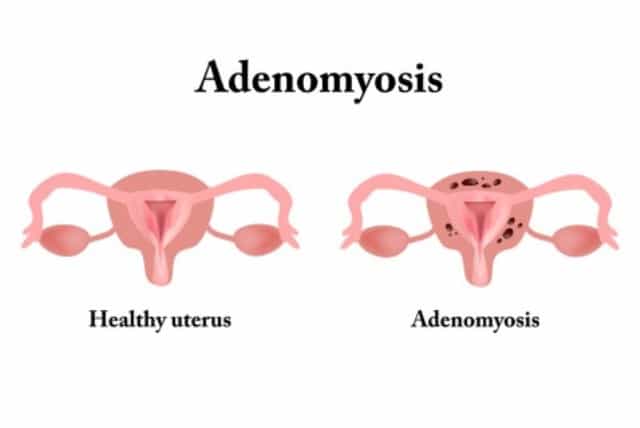
Adenomyosis is a rare gynecologic condition in which the lining of the uterus grows into a muscular uterine layer. Endometriosis is similar to this condition but not the same.
However, women with Adenomyosis often have endometriosis. In endometriosis, the cells lining of the uterus are present outside it in other parts such as fallopian tubes.
Adenomyosis causes pain during sexual intercourse and chronic pelvic pain. However, the symptoms are less visible in the beginning in this condition.
It can lead to difficulty in conceiving or sustaining a pregnancy. It is usually found in women between the ages of 35 to 50 but can be present in young women too.
Though it is a benign condition which means it is not life threatening but it can cause severe complications.
To understand, let us first study the uterus. The uterus is commonly called the womb. It is the organ where the baby grows. It is about 7 cm in length and 5 cm in width at the top and 2.5 cm at the bottom.
It is made up of 3 layers. The outermost layer is perimetrium. The middle and innermost layers are myometrium and endometrium respectively. The endometrium is a mucosal lining.
Further, it has two layers. The endometrium lining sheds off during your menstruation. It gets build up again when the next cycle begins. The ovaries release hormones that stimulate the proliferation of endometrial cells. This is only 1% of the uterus.
However, it is enough that allows you to understand what happens in adenomyosis.
Some general facts about adenomyosis that you may not know
- Adenomyosis is not a psychological problem. If anyone tells you that it is due to some stress or bad diet, don’t believe them. These are only myths, but today we know that adenomyosis is not normal. It is a disorder that you need to pay attention.
- Adenomyosis is not just bad cramps. Along with cramps, you may suffer from heavy bleeding and large clots. There are many more complications associated with this disorder.
- Doing exercise cannot treat this disorder. The misplaced endometrial cells will not magically return to their place only because you have joined the gym. Exercise is good but doesn’t think it can cure this disease.
- Of course, diet helps reduce the symptoms of the disorder but it is not a cure. It will not cure the disorder labor.
- The exact cause is still unknown. There are only theories for the possible causes of adenomyosis.
Home Remedies To Get Rid Of Adenomyosis
1. Self-Fertility Massage
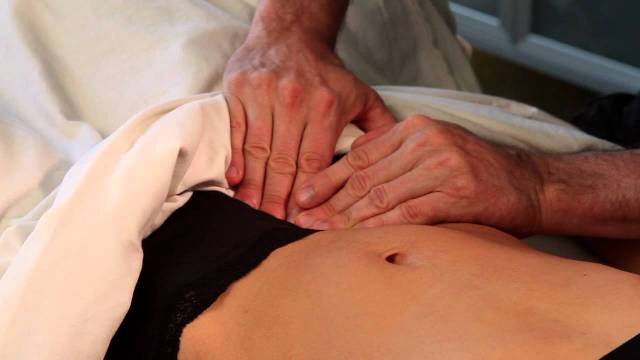
Self-fertility massage will help improve your uterine health. It is simple and cost-effective. For is a series of massage techniques. These will support your reproductive health and normal functioning of the uterus.
This will be effective in getting a regular menstrual cycle. This is a systematic procedure that will help reduce the inflammation and pain. The period is effective in removing the old blood.
This type of massage is effective in treating adenomyosis. The self-fertility massage may help improve the health of your uterus that is affected due to adenomyosis.
Here are some ways that make the self-fertility massage effective in healing adenomyosis:
- It increases the circulation to the uterus, ovaries, and fallopian tubes.
- It maintains a hormonal balance by strengthening the hormonal feedback loop.
- It helps the uterus get rid of the old and stagnant blood.
- It stimulates the production of endorphins that help reduce pain and inflammation of the uterus.
- It brings the fresh and oxygenated blood to the uterus.
- It helps eliminate the large clots from the uterus.
- It helps strengthen the muscle of the uterus.
2. Castor Oil Pack
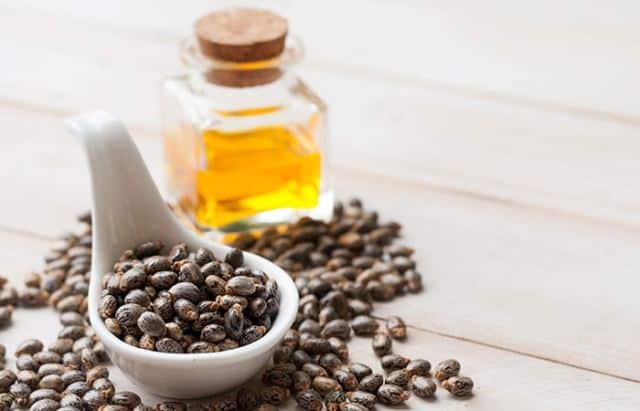
It is an effective and natural remedy to treat Adenomyosis. Castor oil is known to have many benefits for the skin and health. It increases your blood circulation and boosts the healing of tissues. Castor oil repairs the tissue by rejuvenating them.
Castor oil detoxifies the old blood and lowers the inflammation. It works as a natural cleansing agent. It eliminates the scar tissues and growth of foreign tissues.
You Need
- A soft cloth
- Castor oil
Use
- Soak a cloth in castor oil.
- Place it on your skin over the lower abdomen.
Another Method
You Need
- 1 cup of lukewarm milk
- One teaspoon of castor oil
Use
- Add one teaspoon of castor oil in one cup of lukewarm milk.
- Take it daily before going to bed.
3. Herbal Treatment- Slow Flow
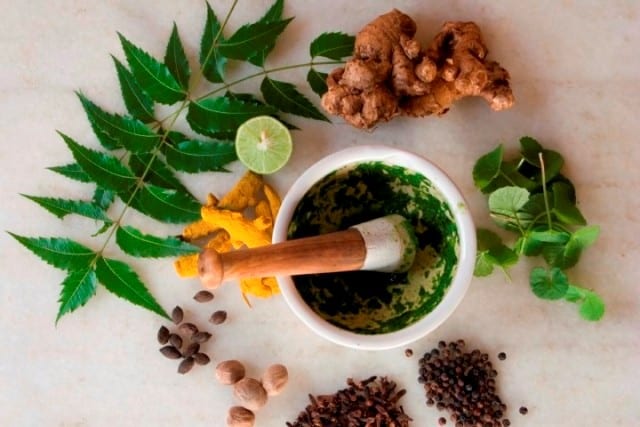
This herbal treatment concerns the combination of powerful herbs. The herbs work together to reduce the pain and heavy flow.
In addition to this, it will fight infections and stimulate liver activity. It also aids in improved estrogen metabolism. It is also effective in promoting progesterone balance.
It is an effective remedy for thyroid. The enzyme protease helps dissolve any foreign and unwanted tissue.
Go through the following recipe and do follow it. It comes from the Susan S. Weed’s protocol.
Weed’s Protocol:
- 1 oz. Licorice (Glycyrrhizaglabra)
- 1 oz. Patridge berry leaf (Mitchellarepens)
- 1 oz. Blue Cohosh rt. (Caulophylumthalictroides)
- 1 oz. Geranium rt. (Geranium spp.)
- 40 drops of cotton rt. Bark (Gossypium)
Mix all the ingredients well. Dosage is one teaspoon, two times a day.
4. Shepherd’s Purse
Shepherd’s purse is a well-known remedy to treat irregular menstrual cycle. It stimulates the uterine contractions and thus helps in reducing bleeding. This herb limits the flow of blood towards your pelvic region as it constricts the blood vessels.
CAUTION- Avoid it using while you are pregnant.
5. Ginger

How often you use ginger in tea? Ginger is the very common dietary staple in many countries. It is gaining more popularity with time. Antioxidants such as gingerols help reduce swelling in the uterus.
The anti-inflammatory properties aids in the normal functioning of the uterus. Ginger has analgesic properties that help in reducing pain during menstruation.
How To Take Ginger
The best and simplest way is to make ginger tea.You can also include it in your food.
6. Turmeric
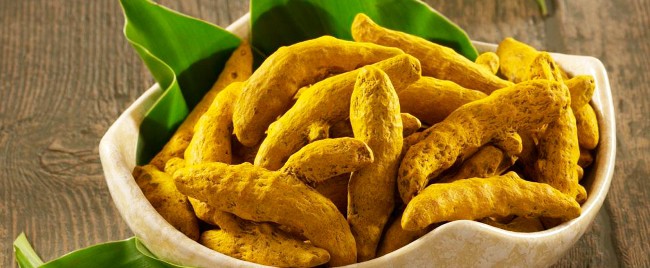
Turmeric is known to have medicinal value. It is very often used to get relief from arthritis. It works wonders for Adenomyosis.
Turmeric contains curcumin that helps in reducing the inflammation in the uterus. It also helps to reduce the amount of blood during menstrual flow.
You Need
- ½ teaspoon of turmeric powder
- 1 teaspoon of desi ghee or butter
- 3-4 black raisins
- 1-2 tablespoons crushed walnut kernels
- 4-5 crushed almonds
- 1 crushed dry date
- 1 cup of milk
Use
- Fry all the ingredients in desi ghee or butter.
- Add 1 large cup of milk in it and boil the mixture.
- Take it daily for one or two weeks.
7. Pineapple
Pineapple contains bromelain that helps reduce the inflammation of internal body organs. It also helps you get rid of the internal infections. It is one of the best natural remedies to treat your enlarged uterus.
Use
Drink pineapple juice daily or eat pineapple slices.
8. Yogurt
Yogurt is a common dietary staple. It is rich in healthy probiotics that keep your uterus healthy. It helps reduce inflammation and infections of your internal body organs.
Use
- Take a large bowl of yogurt daily before breakfast.
- Avoid adding sugar to it. Instead, add some fruits.
9. Vitex
Vitex is the dried fruit of the chaste tree. It is a natural and well-known remedy to treat Adenomyosis. The compounds present in Vitex have the same effects of testosterone and progesterone. It inhibits the production of estrogen in the body.
Lower levels of estrogen help in eliminating the symptoms of Adenomyosis. It influences the pituitary gland to produce luteinizing hormone (LH).
Luteinizing hormone stimulates the production of more progesterone by the ovaries. Vitex may be beneficial to the women suffering from excessive bleeding. It can be due to impaired ovarian function.
10. Keishi-Bukuryo-Gan
It is a Japanese herbal remedy. It is mainly used to treat gynecological problems. It is also effective in curing adenomyosis though not many women are aware of it. It is still under study.
Thus, we would suggest you consult a physician before taking this herb. Also, the side effects of this treatment are not known until now.
11. Calcium And Magnesium
These two minerals play an important role in the menstruation process. Calcium and magnesium regulate your menstrual cycle. Taking this mineral in diet can also be helpful. Make sure that your body is not deficient in these minerals.
Also, ensure to have the sufficient amount of these minerals as an extra amount can also be risky.Include the foods rich in calcium and magnesium in your diet such as:
12. Heating Pads
Heat also helps in relaxing the contracting muscles of the uterus. You get relief from the menstrual cramps when you use heat.
Use
- Place a heating pad over your lower abdomen.
- You can also use a hot water bag instead of the heating pad.
Alternatively, you can also take a hot water bath to reduce the pain.
13. Aloe Vera
Aloe Vera is very common that most of the women use for hair and skin problems. It has many health benefits. Aloe Vera helps in regulating the menstrual flow and prevents cramps. It reduces the pressure on the uterus and eliminates the pain.
Use
- Drink Aloe Vera juice daily twice a day to gain its maximum benefits.
- Also, you can apply fresh Aloe Vera gel to the affected area to reduce cramps.
14. Aromatherapy
Aromatherapy is now famous in the beauty industry. It is huge product among luxury brands too. In real aromatherapy is natural. You may switch to it for treating menstrual cramps. Essential oils are the most important components of this therapy.
Clary sage and marjoram are the two important essential oils present in it. It is a good product to treat the discomfort during adenomyosis.
Warmth and essential oils go hand in hand. So, use a hot compress made with these oils. These essential oils are a great therapy to treat pain and cramps due to adenomyosis.
Use
- You can use hot compresses of these essential oils over your lower abdominal area.
- It will help you get rid of the symptoms of this disease.
15. Cinnamon Powder

The cinnamon powder contains antioxidants that help reduce the inflammation of body organs. It is a magical herb that treats menstruation disorders. It helps in controlling the enlarged uterus problems.
You Need
- ¼ tsp. of cinnamon powder
- 1 glass of lukewarm water
How To Use
- Mix cinnamon powder in 1 glass of water.
- Drink it daily for 2-3 times a day.
16. Flaxseed
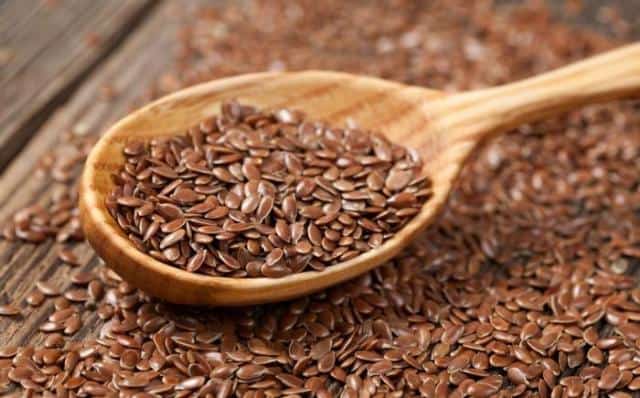
Flaxseed is a well-known herb to treat many health consequences. It is a natural and effective herb to flush out toxins from your body. Flaxseed contains fibers and omega-3 fatty acid that helps reduce the inflammation.
Omega-3 fatty acid is also an essential fatty acid that is not synthesized by your body. Thus you must include food rich in omega 3 fatty acids to avoid suffering from its deficiency.
You Need
- 1 or 2 tablespoons of crushed flax seeds
- 1 glass milk
Use
- Boil crushed flax seeds in 1 glass of milk.
- Let it boil until the quantity reduces to half.
- Drink it daily before going to bed.
17. Chia Seeds With Jaggery Syrup
Chia seeds are rich in omega 3 fatty acids, potassium, and other minerals. Using the chia seeds is the most effective remedy to treat inflammation and body abscess.
The vitamins and minerals present in chia seeds eliminate the toxins. They even cleanse the veins naturally.
You Need
- 2 tablespoons of chia seeds
- 1 cup of water
- One glass of jaggery syrup
Use
- Soak the chia seeds in one cup of water for 2 hours.
- Mix the chia seeds in one glass of jaggery syrup.
- Drink it daily in the evening for two-three weeks.
18. Fennel Seeds
Fennel seeds help to reduce the enlarged uterus. It is very effective in treating Adenomyosis. Using the fennel seeds strengthen the uterus muscles naturally.
You Need
- 1 cup of boiled water
- ½ teaspoon of fennel seeds
- ½ teaspoon of green cardamom powder
Use
- Mix fennel seeds and cardamom powder in one cup of boiled water.
- Have it daily after every meal.
19. Dong Quai
It is a well-known herb to treat menstrual problems. Chinese women often use its syrup as a tonic for reproductive health. It reduces the pain during menstrual flow.
It suppresses the estradiol synthesis. It means that it has a very little estrogenic activity.
Also, it helps in dilating the blood vessels and relaxes the uterine muscles. This herb reduces inflammation by increasing the blood circulation in the uterine wall.
You Need
- Dried Dong Quai roots
- One cup of boiled water
Use
- Make a fine powder with dried Dong Quai roots.
- Add ¼ teaspoon of Dong Quai powder in a cup of boiled water.
- Cover it for 5-7 minutes.
- Have it daily for one or two weeks.
20. Dandelion

Dandelion is little and yellowish. This is an invaluable herb. People often call it as pee in the bed. It is a powerful diuretic that eliminates the symptoms such as bloating.
You may use diuretic drugs such as Lasix. Lasix cause your body to lose large quantities of potassium.
Dandelion is one such herb that does not affect the potassium quantities in your body. It is also useful in treating reproductive hormone related consequences.
One of the best natural remedies to remove the mucus is the dandelion. It also prevents excessive inflammation of the uterine muscles.
You Need
- ½ a teaspoon of dandelion herb powder
- 1 cup of boiled water
Use
- Mix dandelion herb powder in boiled water.
- Let it steep for about 5 minutes.
- Strain it and then drink it for twice a day.
21. Licorice
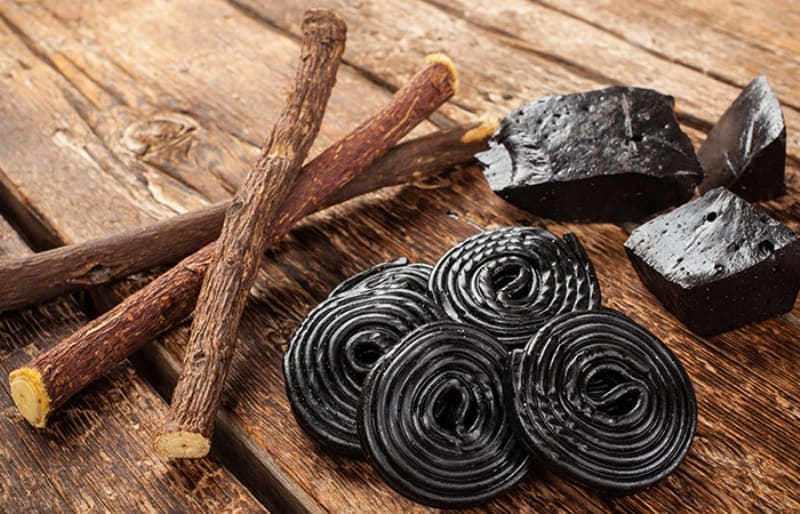
Licorice helps reduce the excessive production of mucus and fluids in the uterus. It also inhibits the enlargement of the uterus. It is because it inhibits the mucus-producing glands naturally.
You Need
- 50 grams licorice
- A glass bottle
- A glass of water or sandalwood syrup
Use
- Make a fine powder with 50 grams licorice and store it in a glass bottle.
- Take the ¼ teaspoon of powder with water or sandalwood syrup.
- Repeat it daily before going to bed to get the best results.
22. Fenugreek Leaves
Fenugreek leaves help reduce the menstrual pain and cramps.
You Need
- 50 grams of fenugreek leaves
- 50 grams of nigella seeds
- 500 ml of olive oil
Use
- Boil fenugreek leaves and nigella seeds in olive oil.
- When it starts burning to remove it from the stove.
- Filter the mixture and keep it in a glass bottle.
- Massage with 20-25 drops of lukewarm drops of this oil twice a day.
- It will help you reduce the uterus swelling naturally.
23. Walnuts
Walnuts are rich in essential fatty acids, vitamins, and minerals. They help reduce the inflammation and keep your organs healthy. Omega 3 fatty acids present in walnuts are the essential fatty acids. Include them in your diet.
24. Milk Thistle
This is an amazing herb that protects and nourishes your liver. The liver is the organ where the estrogen is processed. So, it is very important to keep it healthy. Silymarin is an active constituent of this plant.
It protects the liver by eliminating toxins from your body. It has antioxidant properties. It prevents the depletion of glutathione. Glutathione is responsible for the normal functioning of the liver.
It is also beneficial in treating hepatitis and cirrhosis. Add this herb to your diet if you are suffering from adenomyosis.
25. Grape Seed Extract

It is an amazing supplement that acts as a potent aromatase inhibitor. This supplement is beneficial to women suffering from high levels of estrogen. Thus it helps treat adenomyosis. The leaves of grape seed extract have astringent properties.
Thus, they treat heavy menstrual bleeding. In addition to this, the proanthocyanidins present in grape seed extract are antioxidants. They may help in keeping the liver healthy. The extract also benefits women with premenstrual syndrome.
26. Melatonin
Melatonin is the hormone that is produced by the pineal gland. It plays a very important role in regulating the sex hormones.
It reduces the binding to estrogen receptors while increasing to the progesterone receptors. That means it stimulates the progesterone levels that prevents adenomyosis.
27. Oregano
Oregano is one of the highest progesterone binding herbs. The volatile oils in oregano help detoxify your liver. It maintains the levels of estrogen and progesterone.
28. Rosemary
Rosemary is a well-known and effective herb to treat adenomyosis. It lowers the estrogen levels and reduces inflammation of the uterine wall. In addition to this, the volatile oils in rosemary aid in liver detoxification.
29. Black Cohosh
Black cohosh is a wonderful herb of the buttercup family. North American Indians often use it for its many health benefits.
It is a treatment for premenstrual syndrome and menstrual cramps since ages. It is very helpful in treating symptoms of adenomyosis and enlargement of the uterus.
Types
There are two types of adenomyosis that are as follows:
1. Adenomyomas
The first type is adenomyomas or focal. The endometrial cells collect within the well-defined borders of the uterus. They appear like fibroids and are often mistaken as such. Hysterectomy can remove them from the uterus. The size and location of cells can make it difficult sometimes.
2. Diffuse
The second type is the diffuse disease that spreads out within the myometrium of the uterus. The uterus enlarges and becomes hard, making sexual intercourse very difficult. The spread of this disease damages the uterine muscle cells.
Ultimately they lose their ability to contract. It is a major reason behind the miscarriages between the 2nd and 3rd trimester.
Causes Of Adenomyosis

The exact cause is still not known. But there are various theories on the causes of this condition. These possible causes include:
1. Absence Of Endometrium
The absence of the endometrium is one of the reasons behind this often-painful condition. Sometimes, your uterus fails to produce the endometrium for the menstrual cycle. It often disturbs the menstrual cycle and normal functioning of the uterus.
2. Invasive Tissue Growth
Experts believe it to be the result of the direct invasion of the endometrial cells into the muscular uterine walls. The uterine incisions made during an operation such as a cesarean section may promote Adenomyosis.
3. Uterine Inflammation Due To Childbirth
There is another theory than links Adenomyosis to childbirth. An inflammation may develop in the uterine lining during the postpartum period. That can also be the cause of Adenomyosis. It can cause the boundary of cells to break and grow into the muscular layers of the uterus.
4. Developmental Origins
Some other experts relate it to developmental origins. It is the consequence of the deposition of endometrial tissues in the uterus when it is first formed. This condition can be due to some complications in the formation of the reproductive system.
5. Stem Cell Origins
A recent theory states that bone marrow stem cells may be one of the causes of Adenomyosis. The stem cells may invade the uterine muscles through the lymphatic system. It leads to Adenomyosis.
6. Injuries
Theories include tissue trauma or vaginal injury as one of the causes of adenomyosis. These conditions can allow the inflammation of the uterus.
It can lead to an increase in the macrophages and cytokines to migrate into the muscle layer (myometrium). That ultimately causes the growth of tissues in this area or adenomyosis.
7. Hormonal Levels
It also depends on the circulating estrogen in a woman’s body. Some experts say that the migration of cells into myometrium can be due to hormonal levels. A high expression of estrogen receptors can also cause adenomyosis.
High levels of estrogen stimulate the spread of this disease quickly. A high level of prolactin can also cause the shift of the endometrial cells causing adenomyosis.
Symptoms Of Adenomyosis

The main symptom of Adenomyosis is uterine cramps. Some women may suffer from chronic pain in the lower abdomen. The symptoms are similar to the symptoms of endometriosis. There are cases when women do not have symptoms of this disease.
Signs that can help you determine the presence of Adenomyosis disease
- Dysmenorrhea (severe pain during periods)
- Hypermenorrhea (heavy periods)
- Prolonged bleeding cycles
- Cramps
- Large clots
- Abdominal bloating
- Back pain
- Severe abdominal pain throughout the month
- Pain during sexual intercourse
- Nausea and vomiting
- Irritation
- Bowel and bladder issues
Some of the clinical symptoms may appear if the condition gets very severe such as:
- Uterine enlargement that may lead to pelvic fullness
- Tender uterus
- Infertility
- Premature rupture of membranes
- Preterm labor
How Fatal Is Adenomyosis?
Women with adenomyosis have symptoms like heavy bleeding and large clots. Chronic pain is less common. But adenomyosis can prove to be dangerous though its symptoms are not so severe. It can lead to infertility.
Patients with adenomyosis show the abnormal immune response. It stimulates macrophages to produce nitric oxide in large amounts. This leads to impede fertilization and implantation. Excess of nitric oxide may also predispose to early miscarriage.
Also, the blockage of the opening between the uterus and fallopian tubes interfere in pregnancy. This is because that is the path for the sperm to travel and fuse with the ovum.
Thus, women with adenomyosis may suffer from infertility and difficulties in conceiving.
- Adenomyosis leads to very similar disease endometriosis. It is often seen that women with adenomyosis suffer from endometriosis too.
- Adenomyosis also causes fibroids in some women. Uterine fibroids are a result of adenomyosis when you don’t treat it in time.
- Patients with adenomyosis often have anemia (deficiency of hemoglobin in the blood). This results in a dull and pallor appearance.
Pregnancy And Adenomyosis

It is uncertain whether adenomyosis can cause infertility. The reason is that women with adenomyosis often have endometriosis which is a well-known cause of infertility.
However, there are many reasons that suspect adenomyosis to be a cause of infertility. The very first reason being uterine contractions. Uterine contractions are good. The contractions in the uterus and fallopian tubes allow the sperm to reach the ovum (female egg).
Adenomyosis is more likely to cause frequent contractions and disturbs the natural mechanism. The increased frequency of contractions during implantation is much worse. Adenomyosis may stimulate these bad contractions in the uterus.
There is one more reason for it. The factors responsible for the development of adenomyosis may affect the uterus. They make the uterus unable to implant the fertilized egg. So, difficulty often occurs during the implantation of the embryo.
Diagnosis
Diagnosis is necessary for planning the course of treatment. First, it is the physical examination of the swollen uterus. The next step is an ultrasound. This lets your doctor understand the condition of your uterus.
In some cases, the doctor may need your MRI scan. It will provide a high-resolution picture of your internal organs. That makes it easy for the doctor to get the severity of the condition.
Yoga Asanas For Adenomyosis

Experts also recommend yoga to treat the symptoms of this disorder. Here are the effective yoga asanas:
- AdhoMukhasana
- SuptaBadhha
- Konasana
- Bhujangasana
- UtthitaAnguliSukhasana
Practice these yoga asanas every day for 20 minutes. It will help you gain the benefits and get rid of the symptoms of this painful disorder.
CAUTION– Do not practice these yoga asanas while on periods.
Final Talk
It is true that adenomyosis is a very painful condition. However, natural home remedies are very effective in treating this disease. Using natural remedies instead of allopathic ones never goes out of style.
It is much safer and better alternative to artificial medicines. I have also mentioned some tips that can help you treat this painful condition.
However, make sure that you are not taking these herbs with certain medications. They do interact with certain medications and can prove to be harmful. So, it is better to consult your physician before using any of them.





